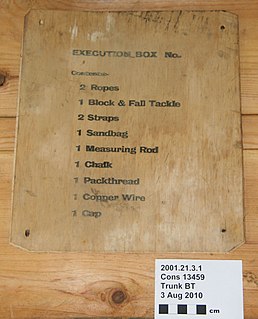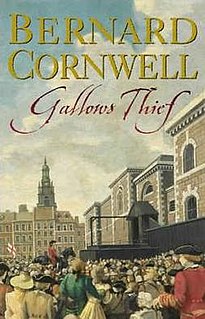
Tyburn was a manor (estate) in the county of Middlesex, one of two which were served by the parish of Marylebone.

Newgate Prison was a prison at the corner of Newgate Street and Old Bailey Street just inside the City of London, England, originally at the site of Newgate, a gate in the Roman London Wall. Built in the 12th century and demolished in 1904, the prison was extended and rebuilt many times, and remained in use for over 700 years, from 1188 to 1902.

Hanging is the suspension of a person by a noose or ligature around the neck. The Oxford English Dictionary states that hanging in this sense is "specifically to put to death by suspension by the neck", though it formerly also referred to crucifixion and death by impalement in which the body would remain "hanging". Hanging has been a common method of capital punishment since medieval times, and is the primary execution method in numerous countries and regions. The first known account of execution by hanging was in Homer's Odyssey. In this specialised meaning of the common word hang, the past and past participle is hanged instead of hung.

Albert Pierrepoint was an English hangman who executed between 435 and 600 people in a 25-year career that ended in 1956. His father Henry and uncle Thomas were official hangmen before him.
Harry Bernard Allen was one of Britain's last official executioners, officiating between 1941 and 1964. He was chief executioner at 41 executions and acted as assistant executioner at 53 others, at various prisons in England, Scotland, Northern Ireland, the Channel Islands and Cyprus. He acted as assistant executioner for 14 years, mostly to Albert Pierrepoint from 1941 to 1955.
Capital punishment in the United Kingdom was used from ancient times until the second half of the 20th century. The last executions in the United Kingdom were by hanging, and took place in 1964, before capital punishment was suspended for murder in 1965 and finally abolished for murder in 1969. Although unused, the death penalty remained a legally defined punishment for certain offences such as treason until it was completely abolished in 1998. In 2004 the 13th Protocol to the European Convention on Human Rights became binding on the United Kingdom, prohibiting the restoration of the death penalty for as long as the UK is a party to the convention.

William Marwood was a hangman for the British government. He developed the technique of hanging known as the "long drop".

Capital punishment in New Zealand, the process of sentencing convicted offenders to death for the most serious crimes and carrying out that sentence, as ordered by a legal system, first appeared in a codified form when New Zealand became a British colony in 1840. It was first carried out with a public hanging in Victoria St, Auckland in 1842, while the last execution occurred in 1957 at Mount Eden Prison, also in Auckland. In total, 85 people have been executed in New Zealand.

HM Prison Leicester is a local men's prison, located on Welford Road in the centre of Leicester, Leicestershire, England. The term 'local' means that the prison holds people on remand to the local courts, as well as sentenced prisoners. Leicester Prison is operated by Her Majesty's Prison Service, and is situated immediately north of Nelson Mandela Park.
Ada Chard Williams (1875–1900) was a baby farmer who was convicted of strangling to death 21-month-old Selina Ellen Jones in Barnes in London in September 1899.

The Radlett murder, also known as the Elstree murder, was an 1823 murder in Radlett, Hertfordshire, England, in the United Kingdom. The victim, William Weare, was killed in Radlett and the body disposed of in a pond in nearby Elstree. The crime gained a great deal of attention and was the subject of numerous books and stage plays. It is commemorated by the rhyme:
There are obvious inconsistencies between this article and John Foxton, see talk page

The Red Barn Murder was a notorious 1827 murder committed in Polstead, Suffolk, England, in which a young woman, Maria Marten, was shot dead by her lover, William Corder. The two had arranged to meet at the Red Barn, a local landmark, before eloping to Ipswich. Marten was never seen alive again and Corder fled the scene. He sent letters to Marten's family claiming that she was in good health, but her body was later discovered buried in the barn after her stepmother spoke of having dreamed about the murder.

Gallows Thief (2001) is a historical mystery novel by Bernard Cornwell set in London, England in the year 1817, which uses capital punishment as its backdrop.

William Calcraft was a 19th-century English hangman, one of the most prolific of British executioners. It is estimated in his 45-year career he carried out 450 executions. A cobbler by trade, Calcraft was initially recruited to flog juvenile offenders held in Newgate Prison. While selling meat pies on streets around the prison, Calcraft met the City of London's hangman, John Foxton.

The Capital Punishment Amendment Act 1868 received Royal Assent on 29 May 1868, putting an end to public executions for murder in the United Kingdom. The act required that all prisoners sentenced to death for murder be executed within the walls of the prison in which they were being held, and that their bodies be buried in the prison grounds. It was prompted at least in part by the efforts of reformers such as Sir Robert Peel and Charles Dickens, who called in the national press for an end to the "grotesque spectacle" of public executions. Abolition of public executions was one of the recommendations of the Royal Commission on Capital Punishment 1864-1866. A similar measure, the Capital Punishment within Prisons Bill, had been introduced in 1867, but failed for lack of parliamentary time.

James Billington was a hangman for the British government from 1884 until 1901. He is the patriarch of the Billington family. Billington died at home from bronchitis in the early hours of 13 December 1901, ten days after having executed Patrick McKenna, a man he knew well.
James Pratt (1805–1835), also known as John Pratt, and John Smith (1795–1835) were two London men who, in November 1835, became the last two to be executed for sodomy in England. Pratt and Smith were arrested in August of that year after allegedly being spied through a keyhole having sex in the rented room of another man, William Bonill. Bonill, although not present, was transported to Australia as an accessory to the crime, where he died.

The 1807 Newgate disaster or the Old Bailey Accident of 1807 was a human crush that occurred outside London's Newgate Prison on 23 February 1807. The disaster occurred when part of a large, dense crowd gathered to witness a triple execution destabilised after being disturbed by a collapsing wooden cart, which triggered a chain of events leading to a fatal crowd crush. Many fatalities and severe injuries resulted, with newspapers reporting that at least 27 perished in the accident and one observer counting at least 34 dead.














